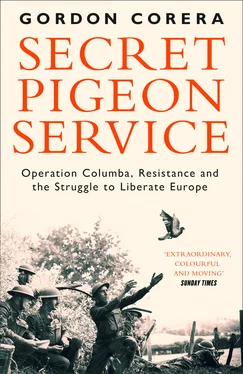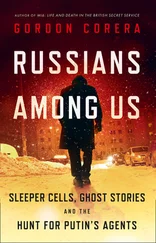A photograph – taken by the Comte de Grunne – shows the scene on the morning of 27 May. Outside the castle among the trees stand four figures in military uniforms, talking in two pairs. On one side is Keyes, standing with the King’s aide-de-camp. On the other side King Leopold is talking to his chaplain, Joseph Raskin. The dark looks on all their faces make clear that they all know the end is at hand. This was the moment referred to by Raskin in the Leopold Vindictive message. He knew Keyes would remember it.
Keyes telephoned Churchill that day to give him the news of the King’s decision, adding that the Belgians would not last much longer. At five that afternoon, the King told Keyes his army had collapsed and he was surrendering. Churchill made clear that a new Belgian government would be formed in exile to disassociate itself from the King and his decision to make peace.
By 8 p.m. Keyes knew he had to move fast to avoid his own capture. As his convoy crossed the country, German parachutists landed around them and opened fire. Keyes made one last plea for the King to leave with him. His decision to stay would prove to be a fateful one for the monarch and for his country. Leopold would now never be a unifying figure. At 10 p.m., Keyes left on a road crowded with refugees. By 1 a.m., he was at the coast and found a fishing boat with two sleeping men on board. With some persuasion (which involved rifles and the promise of money on arrival) he was soon sailing back to England, where by the following morning he was at 10 Downing Street to report the King’s decision to an ‘indignant’ Churchill.
Churchill later claimed wrongly in Parliament that the surrender had exposed the British flank, when in fact the Belgian army’s resistance had protected the British Expeditionary Force as it was evacuated from Dunkirk. But the public needed a scapegoat for the disaster and the Belgian king served the purpose. The British press poured vitriol on the King for what they said was a surrender without warning. Keyes himself sued the Daily Mirror for saying he had been ‘bowing on Brussels carpets in a rat king’s palace’.
The day Keyes had met the chaplain was the day Belgium was lost. In their short time together, a bond may have been forged between the Belgian priest and the British admiral – perhaps over the fact both had spent time in China before war. Raskin the following day had taken a bike from Lichtervelde and ridden in turn to Torhout and then to Bruges. In Bruges he went to the school house of Hector Joye’s wife, which had become a field hospital, and met with the wounded. ‘German troops in the city, sad rainy day,’ he wrote.
The link to Keyes also explains the mystery of the codename taken by the spy network. Leopold was clearly a reference to King Leopold of Belgium. But Vindictive? It was a tribute to Keyes himself. In 1918, as commander of the Dover Patrol, Keyes had been given the mission of blocking the ports of Zeebrugge and Ostend. Ostend proved a challenge until Keyes sent an ageing cruiser with orders for its crew to sink the ship in the harbour entrance. That ship was the Vindictive . Now Raskin had named his spy network in honour of his own king and a British admiral.
For MI14(d), the link to Keyes served to emphasize their new-found source’s credibility. ‘Confirmation of the value and accuracy of message No 37 has been obtained from the GOC [General Officer Commanding] Belgian Army in the UK and Admiral Keyes has assisted in assessing the sender’s bona fides,’ the team recorded.
There is one odd fact though. Nowhere is the name Joseph Raskin recorded. Had Keyes recalled meeting the chaplain but not remembered his name? Or did MI14 want to keep the name of their new agent secret? Either way, it was by the name Leopold Vindictive that the spy network would be known in London.
When Rex Pearson saw the original message 37, he marvelled at the way in which the author had crammed so much into such a small space. For a man who had fought to create Columba, it must have been a moment of validation against all those who had been sceptical of using pigeons. The intelligence from Leopold Vindictive rapidly made its way around Whitehall. In July, 174 pigeons had been released in five operations, but the information they gathered had revealed only limited details of troop movements and concentrations and confirmed one or two weapons dumps previously reported by human sources. Without Leopold Vindictive it would have been a pretty poor return. But its report was of a different class, as was clear even to the sceptics of Columba.
Naval Intelligence had been pretty dismissive of Columba until it saw Leopold Vindictive’s message. The Admiralty said it was a ‘particularly good report’ for its ‘wealth of detail’. Two MI6 reports had suggested the possibility that the Germans might have a naval headquarters, but there had been no confirmation until Leopold Vindictive drew attention to the chateau near Bruges and for the first time revealed its role in invasion plans. ‘Having seen such a detailed report as No. 37 it is clear that action should be taken’ in the event of an invasion, Naval Intelligence noted. Further photographic reconnaissance was ordered on the sites mentioned in the report.
There had been questions about Columba and its value. Was the bizarre scheme really going to work? Message 37 put those concerns to bed. Keep it going, but under regular review, was the order from the top of Military Intelligence. Columba offered speed and relevance. It is not hard to imagine that for Claude Dansey at MI6, whose service had been one of the sceptics, there was a touch of jealousy that this strange sideshow had suddenly delivered results that gained the appreciation of the rest of Whitehall whilst he still struggled to rebuild his European networks. One of the many secrets that Dansey was keeping was just how little real intelligence his own agents had so far delivered.
Something else happened to message 37. It was shown to Churchill himself. Why? Churchill loved intelligence and asked to see fresh Enigma decrypts from Bletchley every day to help him guide the war. Significant as the specific details of the intelligence in message 37 were, though, there was no reason he needed to know the exact location of a particular ammunition dump, or even a naval headquarters. The real reason was different. The message from Leopold Vindictive represented much more than just a collection of useful facts. It represented the spirit of resistance, confirming to Britain’s spies and leaders in that troubled hour, when they still feared invasion and when defeat seemed possible – perhaps even likely – that some of those living under the tyranny of Nazi occupation in Europe were willing to risk their lives to help. It was a sign of a spirit that Churchill hoped to inspire in the British people should the disaster of invasion ever befall them; a sign that out there in Europe were people who wanted to work with Britain and who stood ready should Britain be able to return to the continent to drive the Nazis back. All that was required now was for the two sides who needed each other so much to be able to communicate. A humble Ipswich pigeon had made that possible. Both sides were determined that this should be just the beginning. So now the question was, could they manage to get back in touch with the bearded chaplain?
Конец ознакомительного фрагмента.
Текст предоставлен ООО «ЛитРес».
Прочитайте эту книгу целиком, на ЛитРес.
Безопасно оплатить книгу можно банковской картой Visa, MasterCard, Maestro, со счета мобильного телефона, с платежного терминала, в салоне МТС или Связной, через PayPal, WebMoney, Яндекс.Деньги, QIWI Кошелек, бонусными картами или другим удобным Вам способом.












